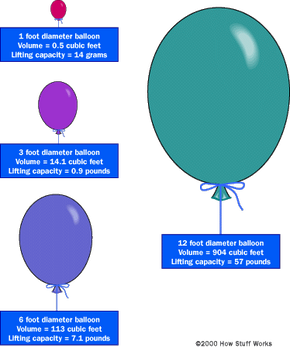Helium Flotation
Helium balloons work by the same law of buoyancy. In this case, the helium balloon that you hold by a string is floating in a "pool" of air (when you stand underwater at the bottom of a swimming pool, you are standing in a "pool of water" maybe 10 feet deep — when you stand in an open field you are standing at the bottom of a "pool of air" that is many miles deep). The helium balloon displaces an amount of air (just like the empty bottle displaces an amount of water). As long as the helium plus the balloon is lighter than the air it displaces, the balloon will float in the air.
It turns out that helium is a lot lighter than air. The difference is not as great as it is between water and air (a liter of water weighs about 1,000 grams, while a liter of air weighs about 1 gram), but it is significant. Helium weighs 0.1785 grams per liter. Nitrogen weighs 1.2506 grams per liter, and since nitrogen makes up about 80 percent of the air we breathe, 1.25 grams is a good approximation for the weight of a liter of air.
Advertisement
Therefore, if you were to fill a 1-liter soda bottle full of helium, the bottle would weigh about 1 gram less than the same bottle filled with air. That doesn't sound like much — the bottle itself weighs more than a gram, so it won't float. However, in large volumes, the 1-gram-per-liter difference between air and helium can really add up. This explains why blimps and balloons are generally quite large — they have to displace a lot of air to float. The following diagram shows the different lifting capacities of different volumes of helium:

A 100-foot-diameter balloon can lift 33,000 pounds. Here is how you can figure out the lifting capacity of the helium in a spherical helium balloon:
- Determine the volume of the balloon. The volume of a sphere is 4/3 * pi * r3, where r is the radius of the balloon. So first determine the radius of the sphere (the radius is half the diameter). Cube the radius (multiply it by itself twice: r*r*r), multiply by 4/3 and then multiply by pi. If you are measuring your balloon in feet, that gives you the volume of the balloon in cubic feet.
- One cubic foot of helium will lift about 28.2 grams, so multiply the volume of the balloon by 28.2.
- Divide by 448 — the number of grams in a pound — to determine the number of pounds it can lift.
So, for example, a 20-foot balloon has a radius of 10 feet. 10* 10 * 10 * 3.14 * 4/3 = 4,186 cubic feet of volume. 4,186 cubic feet * 28.2 grams/cubic feet = 118,064 grams. 118,064 grams / 448 grams per pound = 263 pounds of lifting force.
Although not used much anymore, hydrogen balloons were once quite popular. Hydrogen weighs just 0.08988 grams per liter. However, it is highly flammable, so the slightest spark can cause a huge explosion.
So why are helium and hydrogen so much lighter than air? It's because the hydrogen and helium atoms are lighter than nitrogen atoms. They have fewer electrons, protons and neutrons than nitrogen atoms do, and that makes them lighter (the approximate atomic weight of hydrogen is 1, helium is 4 and nitrogen is 14). Approximately the same number of atoms of each of these elements fills approximately the same amount of space. Therefore, the gases made of lighter atoms are lighter.
